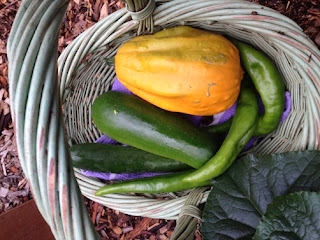The char can be broken up into small pieces or added to the soil “as is". We added the 5 to 7 gallons of char to the Demonstration Bed without breaking it up into smaller pieces or pulverizing it.
Douglas County Master Gardeners' Discovery Garden at River Forks Park, Roseburg, Oregon
October 17, 2015
2015 Biochar Expo
This year’s Biochar Expo attracted some fifty people interested in learning more about biochar. It was held at the Discovery Garden Pavilion.
A Japanese-type, sloping, steel kiln fabricated locally by the UCC Welding Department is used to burn a rick of dry fir and other wood materials. Eventually the rick is pushed down to burn all pieces equally.
Water extinguishes the fire and stops the process.
The char can be broken up into small pieces or added to the soil “as is". We added the 5 to 7 gallons of char to the Demonstration Bed without breaking it up into smaller pieces or pulverizing it.
The char can be broken up into small pieces or added to the soil “as is". We added the 5 to 7 gallons of char to the Demonstration Bed without breaking it up into smaller pieces or pulverizing it.
October 4, 2015
Ending the Season
The last of the peppers and tomatoes were harvested and we began clearing out the plants. We noticed a varmint had already harvested most of the carrots.
Something's been digging in the garden!
Last of the tomatoes!
In this first year crop, few differences between the two sides were noticed. Next year we’ll have to adjust the overhead sprinklers so both sides get adequate and equal water. We will re-test the soil, add amendments as necessary, and plant different crops.
Aside from the onions, carrots and beans, we saw little difference in plant growth between the two beds. Our yields of squashes, cucumbers, peppers and tomatoes were good from both beds. In mid-September, the squash and cucumber plants were removed because of powdery mildew. They had quite overgrown the small space of the gardens.
September 20, 2015
Harvesting the Crop
Here are some of the vegetables harvested from the garden over the summer.
The squash plants were “volunteers” transplanted from the worm beds where they were found sprouting. Unfortunately, they were evidently from hybridized squash and yielded gourd-like produce.
September 15, 2015
Watering the Beds
From June through September, the two biochar beds were sprinkled with water every Monday, Wednesday and Friday along with the other plants in the Discovery Garden; however, because of the very hot weather this summer, both were sprinkled by hand most other days, too. Even with the extra water, the carrots and beans on the non-biochar side did not germinate because the overhead sprinkler often missed that tiny section of the garden. During July, small and curly tomato leaves was evidence of heat distress, but the foliage returned to normal in August as it cooled. Our onions failed to thrive as well, most likely because of crowding and shading.
August 29, 2015
June 13, 2015
Planting the Beds
Each bed was planted with equal numbers of carrots, beans, tomatoes (Sweet Millions), zucchinis, hard squash, Tanja cucumbers, red and white onions, and Anaheim peppers.
June 2, 2015
Adding the Compost
The finished compost was mixed in with the top 6” of both beds, the biochar-charged compost in the bed on the left, and we started planting.
May 22, 2015
Amending the Soil
The soil in the beds was tested by the Douglas County Master Gardeners’ Soil Test Lab and amended according to recommendations: 0.1 lbs Potassium, 0.8 lbs Nitrogen, 0.5 lbs Magnesium.
May 1, 2015
Preparing and Constructing the Beds
4/28/15
We obtained approval to put the beds in back of the Hummingbird Garden in the Compost Area. During the winter, the tall grasses occupying the space were dug up and moved to other areas and the compost started. In April we began screening soil from the Master Gardener topsoil pile and bringing it over to the site.
We obtained approval to put the beds in back of the Hummingbird Garden in the Compost Area. During the winter, the tall grasses occupying the space were dug up and moved to other areas and the compost started. In April we began screening soil from the Master Gardener topsoil pile and bringing it over to the site.
February 27, 2015
Checking on the Compost
When we checked the composters, we found a number of worms in the biochar composter were congregated around its rim and lid, while the ones in the other composter had not. We speculated that the worms were attempting to escape contact, at least temporarily, with the biochar. Perhaps the biochar created an unfriendly environment for them. We decided to leave them alone and see what happened. Within a month, they had apparently returned to the composting materials and we noticed no more unusual worm behavior. We turned the compost in the containers one time during the next four months.
February 13, 2015
Making the Compost
The Compost Team filled two Earth Machine composters (also known as “Darth Vader” composters) with composting materials. Some 100-200 earthworms were also added to each composter. Five gallons of biochar was mixed into one of the composters.
February 11, 2015
Approving the Budget
The Douglas County Master Gardeners’ Executive Board Committee approved the Biochar Demonstration Project materials budget.
February 2, 2015
Obtaining the Biochar
A five-gallon bucket of biochar (approximately .67 cu. ft.) with a known chemical profile was obtained from a local source.
Subscribe to:
Comments (Atom)





























